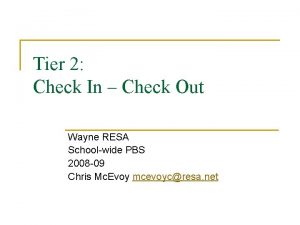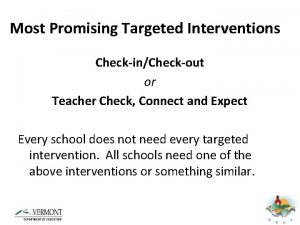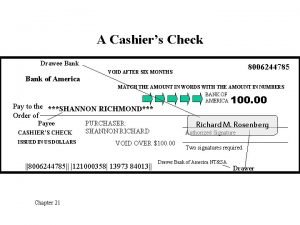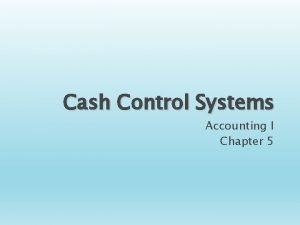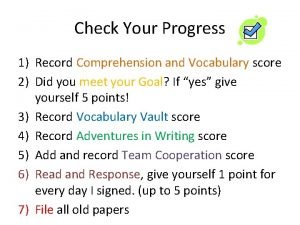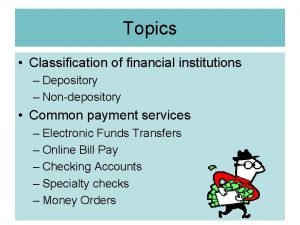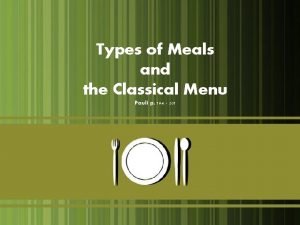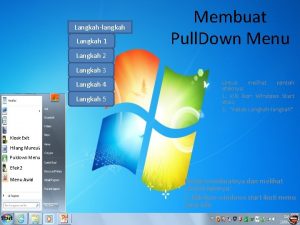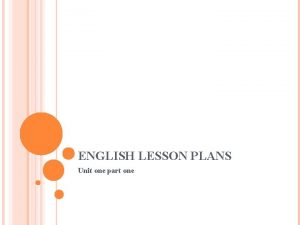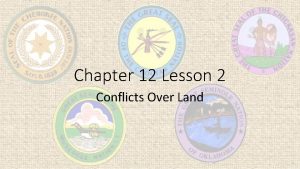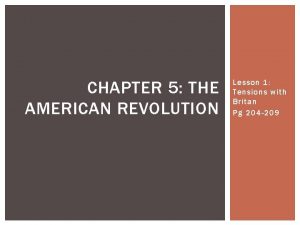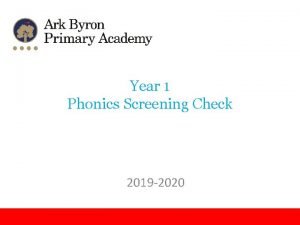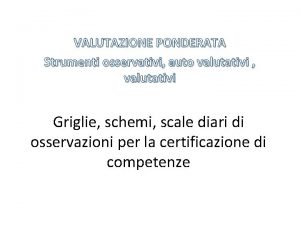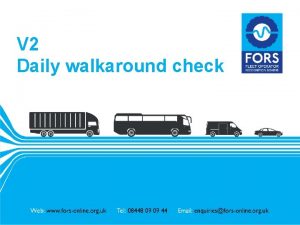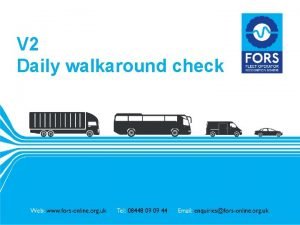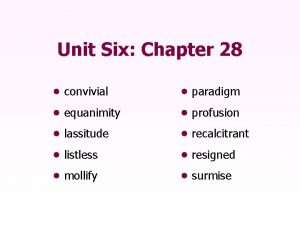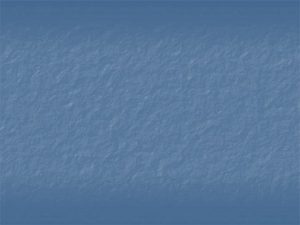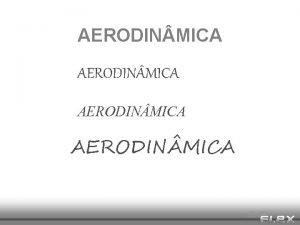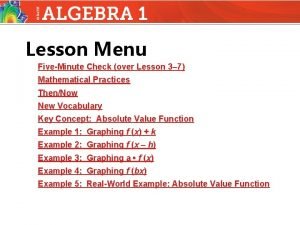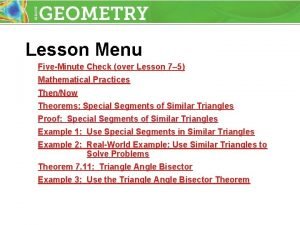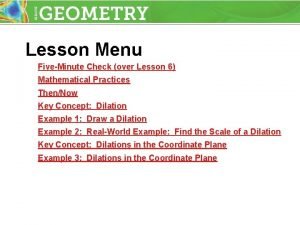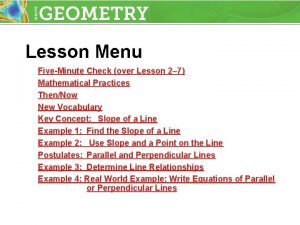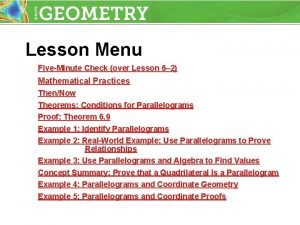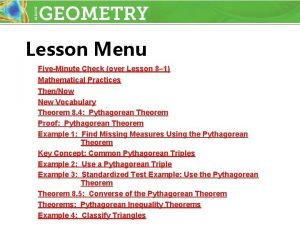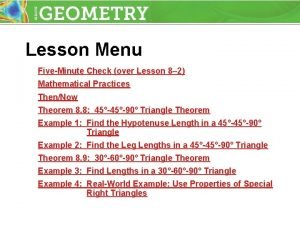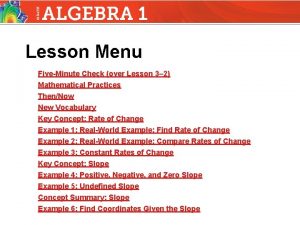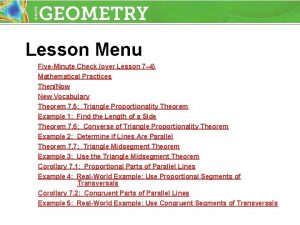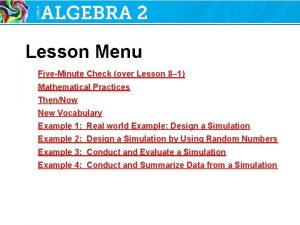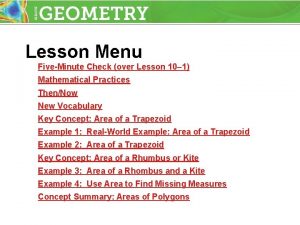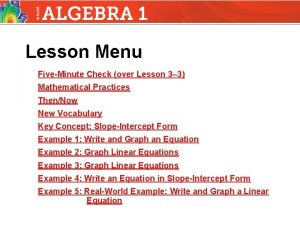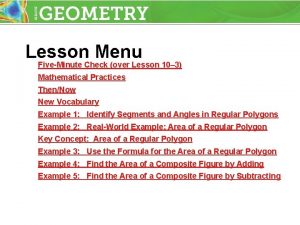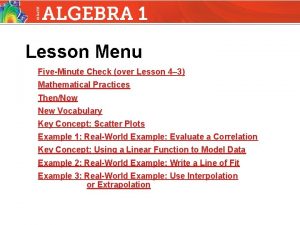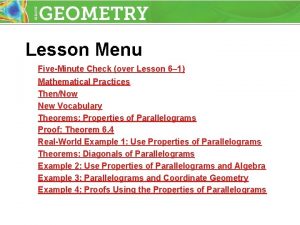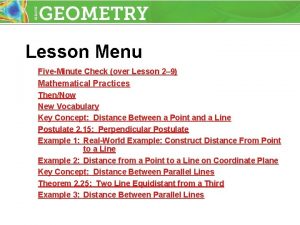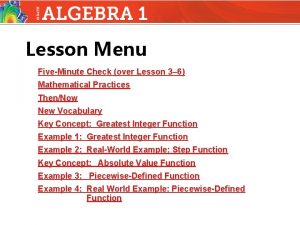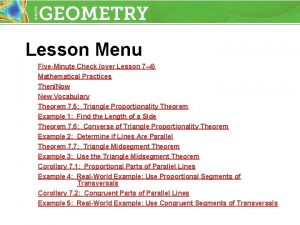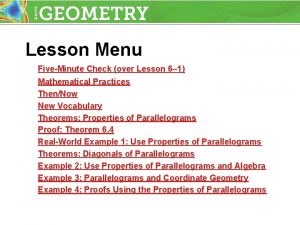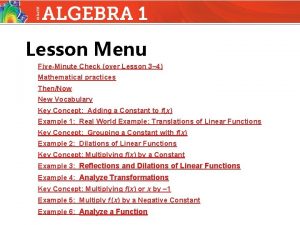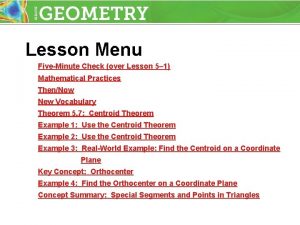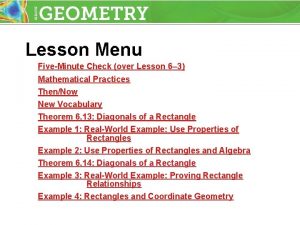Lesson Menu FiveMinute Check over Lesson 6 4
































- Slides: 32

Lesson Menu Five-Minute Check (over Lesson 6– 4) Mathematical Practices Then/Now New Vocabulary Theorems: Diagonals of a Rhombus Proof: Theorem 6. 15 Example 1: Use Properties of a Rhombus Concept Summary: Parallelograms Theorems: Conditions for Rhombi and Squares Example 2: Proofs Using Properties of Rhombi and Squares Example 3: Real-World Example: Use Conditions for Rhombi and Squares Example 4: Classify Quadrilaterals Using Coordinate Geometry

Over Lesson 6– 4 WXYZ is a rectangle. If ZX = 6 x – 4 and WY = 4 x + 14, find ZX. A. 9 B. 36 C. 50 D. 54

Over Lesson 6– 4 WXYZ is a rectangle. If WY = 26 and WR = 3 y + 4, find y. A. 2 B. 3 C. 4 D. 5

Over Lesson 6– 4 WXYZ is a rectangle. If m WXY = 6 a 2 – 6, find a. A. ± 6 B. ± 4 C. ± 3 D. ± 2

Over Lesson 6– 4 RSTU is a rectangle. Find m VRS. A. 38 B. 42 C. 52 D. 54

Over Lesson 6– 4 RSTU is a rectangle. Find m RVU. A. 142 B. 104 C. 76 D. 52

Over Lesson 6– 4 Given ABCD is a rectangle, ___ what is the length of BC? A. 3 units B. 6 units C. 7 units D. 10 units

Mathematical Practices 3 Construct viable arguments and critique the reasoning of others. 2 Reason abstractly and quantitatively. Content Standards G. CO. 11 Prove theorems about parallelograms. G. GPE. 4 Use coordinates to prove simple geometric theorems algebraically. G. CO. 12 Make formal geometric constructions with a variety of tools and methods (compass and straightedge, string, reflective devices, paper folding, dynamic geometric software, etc. ).

You determined whether quadrilaterals were parallelograms and/or rectangles. • Recognize and apply the properties of rhombi and squares. • Determine whether quadrilaterals are rectangles, rhombi, or squares.

• rhombus • square



Use Properties of a Rhombus A. The diagonals of rhombus WXYZ intersect at V. If m WZX = 39. 5°, find m ZYX.

Use Properties of a Rhombus Since WXYZ is a rhombus, diagonal ZX bisects WZY. Therefore, m WZY = 2 m WZX. So, m WZY = 2(39. 5) or 79. Since WXYZ is a rhombus, WZ║XY, and ZY is a transversal. m WZY + m ZYX = 180° 79° + m ZYX = 180° m ZYX = 101° Answer: m ZYX = 101° Consecutive Interior Angles Theorem Substitution Subtract 79 from both sides.

Use Properties of a Rhombus B. ALGEBRA The diagonals of rhombus WXYZ intersect at V. If WX = 8 x – 5 and WZ = 6 x + 3, find x.

Use Properties of a Rhombus WX WZ WX = WZ 8 x – 5 = 6 x + 3 2 x – 5 = 3 2 x = 8 x = 4 Answer: x = 4 By definition, all sides of a rhombus are congruent. Definition of congruence Substitution Subtract 6 x from each side. Add 5 to each side. Divide each side by 4.

A. ABCD is a rhombus. Find m CDB if m ABC = 126. A. m CDB = 126 B. m CDB = 63 C. m CDB = 54 D. m CDB = 27

B. ABCD is a rhombus. If BC = 4 x – 5 and CD = 2 x + 7, find x. A. x = 1 B. x = 3 C. x = 4 D. x = 6



Proofs Using Properties of Rhombi and Squares Write a paragraph proof. Given: LMNP is a parallelogram. 1 2 and 2 6 Prove: LMNP is a rhombus.

Proofs Using Properties of Rhombi and Squares Proof: Since it is given that LMNP is a parallelogram, LM║PN and 1 and 5 are alternate interior angles. Therefore, 1 5. It is also given that 1 2 and 2 6, so 1 6 by substitution and 5 6 by substitution. Answer: Therefore, LN bisects L and N. By Theorem 6. 18, LMNP is a rhombus.

Is there enough information given to prove that ABCD is a rhombus? Given: ABCD is a parallelogram. AD DC Prove: ADCD is a rhombus

A. Yes, if one pair of consecutive sides of a parallelogram are congruent, the parallelogram is a rhombus. B. No, you need more information.

Use Conditions for Rhombi and Squares GARDENING Hector is measuring the boundary of a new garden. He wants the garden to be square. He has set each of the corner stakes 6 feet apart. What does Hector need to know to make sure that the garden is square?

Use Conditions for Rhombi and Squares Answer: Since opposite sides are congruent, the garden is a parallelogram. Since consecutive sides are congruent, the garden is a rhombus. Hector needs to know if the diagonals are congruent, then it is a rectangle. By Theorem 6. 20, if a quadrilateral is a rectangle and a rhombus, then it is a square.

Sachin has a shape he knows to be a parallelogram and all four sides are congruent. Which information does he need to know to determine whether it is also a square? A. The diagonal bisects a pair of opposite angles. B. The diagonals bisect each other. C. The diagonals are perpendicular. D. The diagonals are congruent.

Classify Quadrilaterals Using Coordinate Geometry Determine whether parallelogram ABCD is a rhombus, a rectangle, or a square for A(– 2, – 1), B(– 1, 3), C(3, 2), and D(2, – 2). List all that apply. Explain. Understand Plot the vertices on a coordinate plane.

Classify Quadrilaterals Using Coordinate Geometry It appears from the graph that the parallelogram is a rhombus, rectangle, and a square. Plan If the diagonals are perpendicular, then ABCD is either a rhombus or a square. The diagonals of a rectangle are congruent. If the diagonals are congruent and perpendicular, then ABCD is a square. Solve Use the Distance Formula to compare the lengths of the diagonals.

Classify Quadrilaterals Using Coordinate Geometry Use slope to determine whether the diagonals are perpendicular.

Classify Quadrilaterals Using Coordinate Geometry Since the slope of is the negative reciprocal of the slope of the diagonals are perpendicular. The lengths of and are the same, so the diagonals are congruent. Answer: Check ABCD is a rhombus, a rectangle, and a square. You can verify ABCD is a square by using the Distance Formula to show that all four sides are congruent and by using the Slope Formula to show consecutive sides are perpendicular.

Determine whether parallelogram EFGH is a rhombus, a rectangle, or a square for E(0, – 2), F(– 3, 0), G(– 1, 3), and H(2, 1). List all that apply. A. rhombus only B. rectangle only C. rhombus, rectangle, and square D. none of these
 Behavior check in check out sheet
Behavior check in check out sheet Check in check out forms
Check in check out forms Check in check out
Check in check out Check in check out system for students
Check in check out system for students Cashier check
Cashier check Advantages and disadvantages of scan line fill algorithm
Advantages and disadvantages of scan line fill algorithm Behavior check-in
Behavior check-in Check-in/check-out intervention template
Check-in/check-out intervention template Quickchek menu
Quickchek menu Endorsement
Endorsement Check your progress 1
Check your progress 1 Endorse a check to someone else
Endorse a check to someone else Contoh menu table d hote
Contoh menu table d hote Fungsi menu excel
Fungsi menu excel Cyclical menu
Cyclical menu Sebutkan langkah memulai browsing
Sebutkan langkah memulai browsing Menu pull down exit terdapat pada menu
Menu pull down exit terdapat pada menu Over the mountains over the plains
Over the mountains over the plains Siach reciting the word over and over
Siach reciting the word over and over Explain how to handing over and taking over the watch
Explain how to handing over and taking over the watch Check past form
Check past form Check the old lesson
Check the old lesson Module eleven lesson one self check quiz
Module eleven lesson one self check quiz Chapter 12 lesson 2 conflicts over land
Chapter 12 lesson 2 conflicts over land Lesson 1 trouble over taxes
Lesson 1 trouble over taxes Phonics screening 2019
Phonics screening 2019 Voyage scolaire baux de provence
Voyage scolaire baux de provence Strumenti osservativi
Strumenti osservativi Fors vehicle checklist
Fors vehicle checklist Www.fors-online.org.uk
Www.fors-online.org.uk Convivial in a sentence
Convivial in a sentence Parts of a check
Parts of a check Undertale summary
Undertale summary
